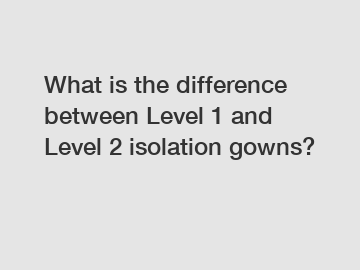Dec. 22, 2023
Health & Medical
What is the difference between Level 1 and Level 2 isolation gowns?
Isolation gowns are essential protective garments used in healthcare settings to minimize the risk of infection transmission and to ensure the safety of medical professionals and patients. These gowns vary in their level of protection, with Level 1 and Level 2 being two common classifications. Understanding the difference between these two levels is crucial in selecting the appropriate gown for a given situation.
The difference between Level 1 and Level 2 isolation gowns lies primarily in their level of fluid resistance. Level 1 gowns offer a lower level of protection compared to Level 2 gowns. According to the Association for the Advancement of Medical Instrumentation (AAMI), Level 1 gowns are designed to provide a minimal barrier against bodily fluids and are suitable for basic care and standard procedures. On the other hand, Level 2 gowns are intended to offer a moderate barrier against fluid splashes and protect against low to moderate levels of aerosols, making them suitable for a wider range of procedures that may involve a higher risk of exposure to bodily fluids.

The classification of isolation gowns into different levels is determined by various factors, including the gown's material, construction, and performance characteristics. Level 1 gowns are typically made of a lightweight, non-woven material such as polypropylene. They are designed to be breathable and comfortable for extended periods of use. These gowns may have minimal fluid resistance properties, and may not be suitable for use in situations involving heavy fluid exposure.
Level 2 isolation gowns, on the other hand, offer a higher level of protection by incorporating additional features such as reinforced areas, densely woven fabrics, or laminated materials. These gowns provide increased resistance against fluid penetration and have better performance capabilities compared to Level 1 gowns. They are usually recommended for use in procedures or situations where there is a higher risk of exposure to bodily fluids, such as during surgical procedures or in areas with a known infectious disease presence.
The importance of selecting the appropriate level of protection cannot be overstated, as it directly impacts the safety of healthcare workers and the prevention of cross-contamination. By ensuring that healthcare professionals have access to gowns that provide an adequate barrier against bodily fluids and aerosols, the risk of infection transmission can be significantly reduced. Additionally, the proper use of isolation gowns according to their designated level also helps in managing healthcare resources effectively, as it avoids the unnecessary use of higher-level gowns where they may not be required.
In conclusion, the difference between Level 1 and Level 2 isolation gowns lies in their level of fluid resistance and protection capabilities. Understanding these differences is crucial in selecting the appropriate gown for different medical procedures and situations. By providing adequate protection to healthcare workers, the risk of infection transmission can be minimized, ultimately ensuring the safety and well-being of both medical professionals and patients.
If you want to learn more, please visit our website PE laminated non-woven fabric, disposable laparotomy pack supplier, surgical disposable sterile kit.
Previous: What is the price of garcinia cambogia?
Next: Are You Getting the Best Value When Buying Bulk Citicoline Sodium?
If you are interested in sending in a Guest Blogger Submission,welcome to write for us!
All Comments ( 0 )